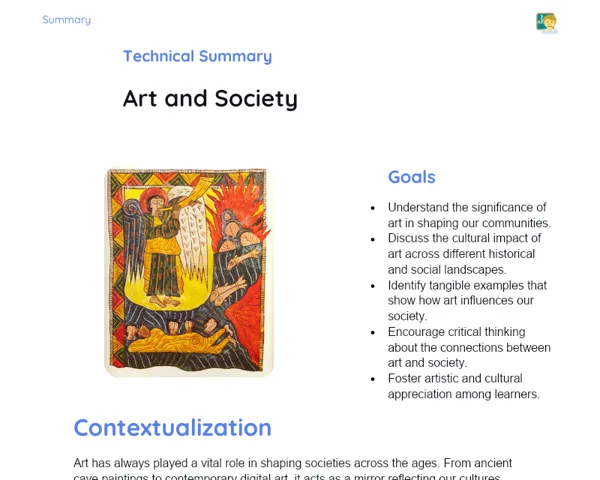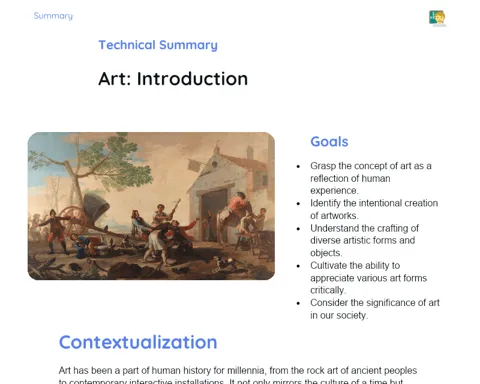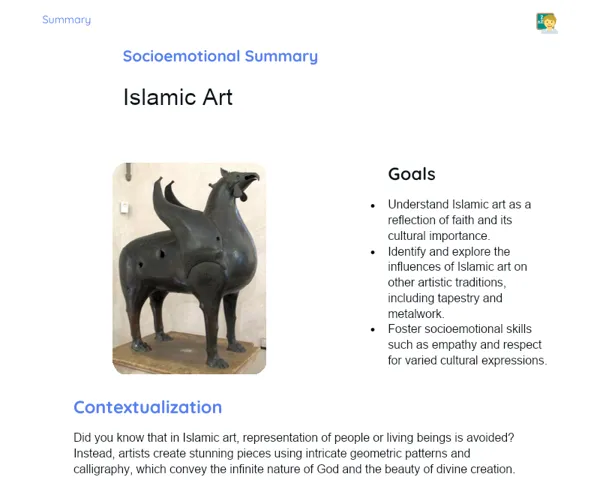Goals
1. Understand the significance of art in ancient Egyptian society, especially its roles in religion and mythology.
2. Examine artistic depictions of everyday life along the banks of the Nile.
3. Cultivate practical skills in reproducing art inspired by ancient Egyptian styles.
Contextualization
In Ancient Egypt, art was far more than just a pretty picture; it was a vital way of communicating ideas and preserving culture. From stunning paintings to intricate sculptures, these works revealed the religious, mythological, and everyday lives of the Egyptians, giving us a rich insight into their society from thousands of years past. To truly grasp this art is to understand how the Egyptians viewed their world, their deities, and their daily lives. For instance, tomb paintings illustrated the deceased's journey to the afterlife, while sculptures and reliefs captured common activities like farming and fishing, painting a comprehensive picture of their beliefs and society.
Subject Relevance
To Remember!
Religious and Mythological Art
Art in Ancient Egypt was closely linked to their religious beliefs and mythology. Paintings, sculptures, and reliefs often depicted gods, goddesses, and mythological narratives that showcased the Egyptians' spiritual customs and rituals. These artistic forms weren’t just decoration; they acted as a bridge to communicate with the divine, serving as guides for the afterlife and as protection from the gods.
-
Representation of Gods: Images of deities were prevalent, with each god having distinct features that marked their identity.
-
Ritual Function: Many art pieces were created specifically for religious rituals, like offering statues and tomb paintings.
-
Symbolism: Symbols, like the Ankh (representing life), were commonly used in these artworks.
Depictions of Daily Life
Egyptian art didn’t just focus on the divine; it vividly captured scenes from everyday life. Paintings and reliefs illustrated activities such as farming, fishing, feasting, and celebrations. These pieces offer invaluable historical records, showcasing a range of daily experiences from mundane tasks to grand social gatherings.
-
Details of Daily Life: The artwork provides rich details about clothing, tools, and techniques employed by the Egyptians.
-
Social Classes: Different classes were illustrated, from pharaohs and aristocrats to farmers and craftspeople.
-
Festivities and Rituals: Artistic portrayals of public celebrations and rituals highlight the significance of community and joy.
Artistic Techniques and Materials
Egyptian artists made use of various materials and techniques to bring their creations to life. Common materials included stone, wood, gold, and natural pigments. Their methods, varying from sculpture and relief to mural painting, displayed a meticulous precision that reflected the skill and dedication of the artists.
-
Materials: Artists used enduring materials like stone and wood, alongside precious metals like gold.
-
Painting Techniques: They employed natural pigments to achieve vibrant colours that have withstood the test of time.
-
Sculpture and Relief: The sculpture and relief techniques in stone were particularly advanced and detailed.
Practical Applications
-
Archaeology: The excavation and conservation methods developed by archaeologists to preserve Egyptian art are influenced by ancient artistic techniques.
-
Jewellery Design: Many modern jewellery designers draw inspiration from the intricate designs and symbolism found in ancient Egyptian jewellery.
-
Art Conservation: Contemporary conservation methods leverage the knowledge of Egyptian materials and skills to restore and protect ancient treasures.
Key Terms
-
Hieroglyphs: The pictographic writing system used in Ancient Egypt.
-
Pharaoh: The title given to the ancient kings of Egypt.
-
Nile: The important river that supported life and agriculture in Ancient Egypt.
-
Ankh: The Egyptian symbol representing eternal life.
-
Mastaba: A type of Egyptian tomb that resembles a bench, used before the construction of pyramids.
Questions for Reflections
-
How did Egyptian art help solidify and convey the religious and mythological beliefs of its time?
-
In what ways do artistic representations of daily life enhance our understanding of ancient Egyptian lifestyles?
-
Which skills and techniques from Egyptian artists remain relevant in today’s professional fields?
Creating an Egyptian Relic
To reinforce our understanding of Egyptian art and techniques, we will create a small relic inspired by traditional Egyptian artifacts.
Instructions
-
Collect materials like cardboard, gold paint, markers, coloured paper, and glue.
-
Draw and cut out Egyptian symbols such as the Ankh, the Eye of Horus, or scarabs.
-
Assemble your shapes in a small cardboard box, decorating it with patterns and colours reflective of Egyptian artwork.
-
Add finishing touches with gold paint to achieve an antiqued look.
-
Present your creation to the class, explaining the symbols chosen and their relevance in Egyptian culture.



